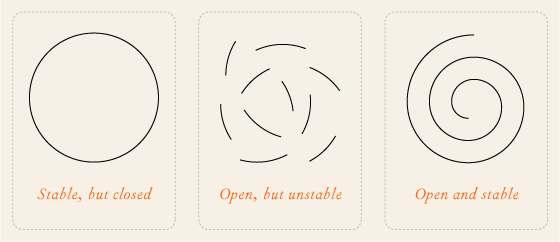Design is the development of 1) systems where the definition of the problem includes elements who are people with some degree of autonomy, and 2) where the production and/or delivery of the designed system involves engineered sub-systems (that is systems that do not include autonomous personal components).
In other words, designed systems are nested systems made up of interacting human and non-human elements (“hybrid systems” as Actor-Network Theory calls them)), and some of the nonhuman elements become engineered systems (ideally explicitly framed as engineering problems).
The idea of design as a system that includes its users as internal to the system is not unprecedented (to name a few Cybernetics, Soft Systems Methodology, and traditional usability engineering have all folded users into their systems) — but it is not widespread among designers, who still tend to view what they make as for people who remain essentially separate from what they are designing.
To sharpen this definition of design it might be useful to define some other design-related activities.
The most important contrast is engineering, which, again, is the development of systems where all elements of the problem are non-autonomous, and predictably follow rules. Autonomous persons are excluded from (defined out of) engineering problems.
Some engineering does involve people but prescribes the rules of their behavior so that they become predictable components of the engineered system. This can be called social engineering. People are controlled and made non-autonomous in social engineering problems.
Naive design is design where the people involved in the designed system are assumed to be as the designer imagines them. In other words, in the course of the design work their goals, behaviors, values, perceptions, conceptions, etc. are not investigated. People are largely imagined in naive design problems.
Human-centered design is design where the people for whom the design is intended (the user, the customer, the audience, etc.) is included within the design problem as substantially unknown. Their personal autonomy requires active investigation, otherwise a critical component of the design’s success is being left to uninformed speculation. To avoid this risk, in human-centered design, the people for whom the design is intended are methodically involved throughout the design process.
As the implications of broader definitions of design come to light, more and more initiatives of various kinds are being recognized as design problems, and are being approached with the sensibilities, methods and tools of design. This has evolved at least one new species of human-centered design, which can be called polycentric design.
Polycentric design is design where multiple interacting people within the designed system are included within the design problem, including not only the primary person for whom the design is intended (user, customer, etc.), but other people involved in the system — ideally all the people who participate in the designed system. Understanding the complexity of such multi-actor interactive systems, and treating each actor as an autonomous person encountering the system from their own lifeworld requires more than a shift of concern — it requires new methods and tools.
Currently, the predominant polycentric design discipline is service design. Of course, services frequently feature multiple actors, and the quality of service depends heavily on the mindset of people delivering it, so it is unsurprising that polycentric design methods are developing in the design of services. But, unless we want to define the word “service” very broadly, the approaches used in service design can be used to design any system where humans are interacting with one another within a hybrid system. To name a few obvious examples, the design of organizations, of public spaces and of online communities could benefit from a polycentric design approach that might differ in important ways from service design.

